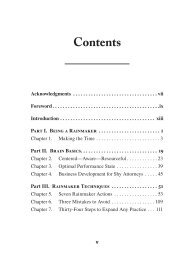(Bk Business) Carol Kinsey Goman Ph.D.-The Nonverbal Advantage_ Secrets and Science of Body Language at Work -Berrett-Koehler Publishers (2008)
Just
Just
You also want an ePaper? Increase the reach of your titles
YUMPU automatically turns print PDFs into web optimized ePapers that Google loves.
62 <strong>The</strong> <strong>Nonverbal</strong> <strong>Advantage</strong><br />
So much for culture! From the jungles <strong>of</strong> Papua New<br />
Guinea to the jam-packed streets <strong>of</strong> New York City, wherever<br />
you go in the world, everyone shares <strong>and</strong> recognizes these<br />
facial gestures—<strong>and</strong> rel<strong>at</strong>es to the emotions they portray.<br />
Because this muscul<strong>at</strong>ure is directly connected to the areas <strong>of</strong><br />
the brain th<strong>at</strong> process emotion, very few people are able to<br />
consciously control all their facial expressions.<br />
Another finding <strong>of</strong> Dr. Ekman <strong>and</strong> his research team<br />
<strong>at</strong> UCSF was how fleeting facial expressions—called microexpressions—<strong>of</strong>ten<br />
allow the truth to slip through in brief,<br />
unguarded moments. Lasting less than one-fifth <strong>of</strong> a second,<br />
these flashes <strong>of</strong> expression are glimpses <strong>of</strong> a person’s<br />
true emotional st<strong>at</strong>e. We don’t think before we feel. Initialreaction<br />
expressions tend to show up on the face before we’re<br />
even conscious <strong>of</strong> experiencing an emotion.<br />
Reading faces is not just a m<strong>at</strong>ter <strong>of</strong> identifying st<strong>at</strong>ic<br />
expressions but also <strong>of</strong> noticing how faces subtly begin to<br />
change. People in face-to-face exchanges w<strong>at</strong>ch each other’s<br />
expressions to gauge reactions to wh<strong>at</strong>’s being said <strong>and</strong><br />
heard. Even when some words are missed, observing the<br />
expression on a speaker’s face can help the listener follow a<br />
convers<strong>at</strong>ion.<br />
Because each emotion has unique, identifiable signals, the<br />
face is the only system th<strong>at</strong> tells us the specific emotion th<strong>at</strong>’s<br />
occurring. Currently, the federal government is funding two<br />
major computer teams—one <strong>at</strong> the University <strong>of</strong> Pittsburgh<br />
<strong>and</strong> one <strong>at</strong> University <strong>of</strong> California <strong>at</strong> San Diego—th<strong>at</strong> are<br />
trying to autom<strong>at</strong>e the Facial Action Coding System developed<br />
by Paul Ekman, Wallace V. Friesen, <strong>and</strong> Joseph C. Hager.<br />
It is predicted th<strong>at</strong> within a few years an autom<strong>at</strong>ic system<br />
will enable computers to produce a readout <strong>of</strong> changes in<br />
your emotional st<strong>at</strong>e, moment by moment.




